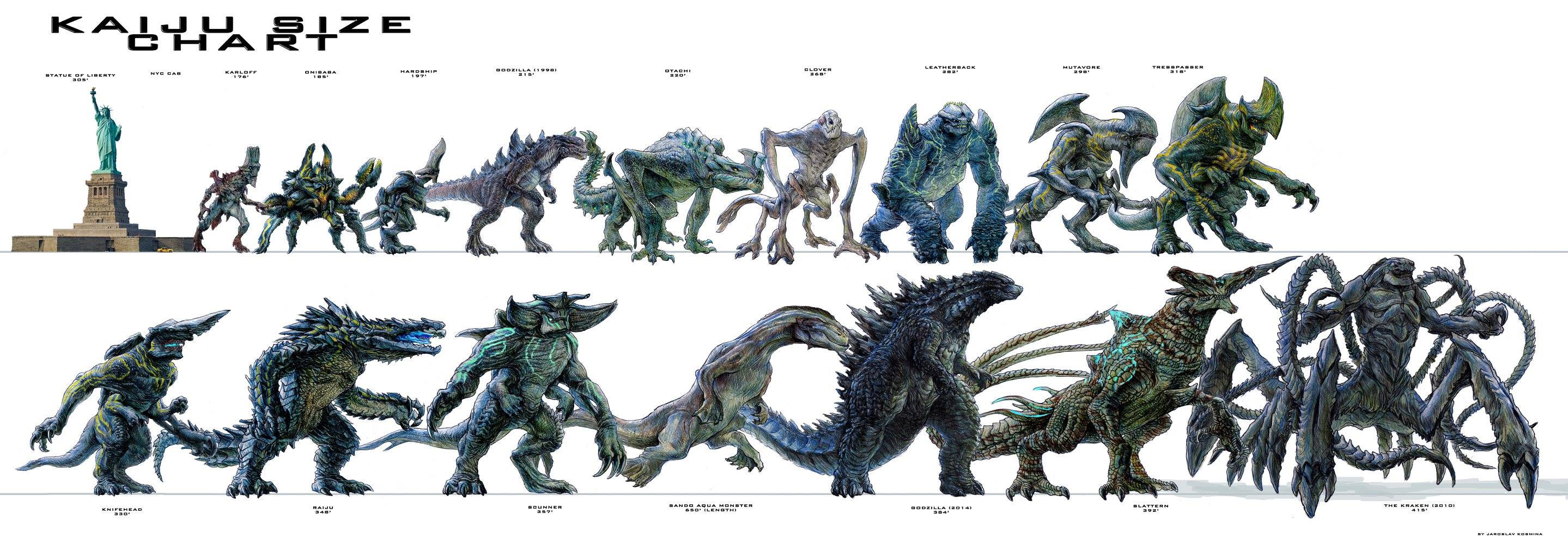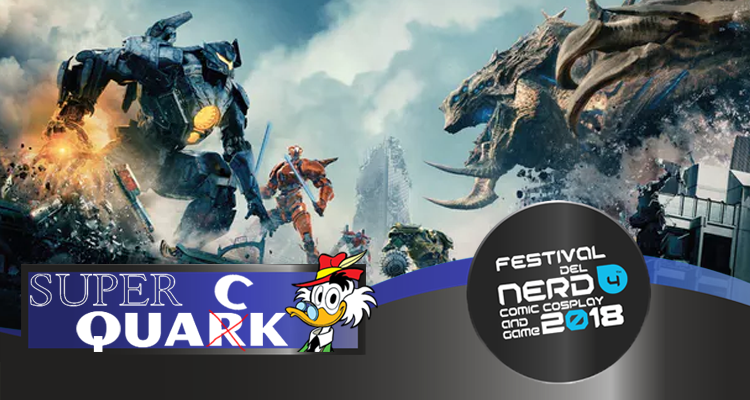I mostri enormi, alieni e non, hanno un fascino indiscutibilmente particolare e fantasioso. Sicuramente, però nella cultura giapponese, fatta di mecha e combattimenti in mega dimensioni, i kaijū (怪獣 lett. “strana bestia”) entrano di diritto nel campo del cinema cult.
La cultura dei kaijū in Occidente si sviluppa prettamente grazie a quelli che sono definiti kaijū eiga (“film di mostri giganti”) con il capostipite della generazione Gojira (Godzilla in Occidente) uscito dagli studi della Toho Company Ldt nel 1954 e creato dalla mente di Tomoyuki Tanaka, rifacendosi ai mostri giganti di Hollywood, come King Kong e il dinosauro de “Il risveglio del dinosauro“. A Godzilla seguirono altri kaijū, ai quali poi si sono affiancati i kaijin, ovvero i “mostri umanoidi”, e i daikaijū, cioè “mostri giganti”.
Storia dei giganti
La parola kaijū è stata utilizzata per la prima volta nel Libro dei monti e dei mari (chiamato anche Shan Hai Jing), descrizione di natura culturale e geografica in chiave favolistica e mitologica della Cina dell’epoca pre-Qin. Di fatto, quindi, l’origine di tali creature è cinese, ma il Giappone ha fatto propria questa mitologia e terminologia utilizzandola per i mostri dei film o delle serie che realizzava. Le creature si rifanno ad animali realmente esistenti o mitologici o a piante rivisitate in forme diverse, ma soprattutto dimensioni. Probabilmente tutto nasce dalla paura suscitata dalle radiazioni post-atomiche e dalle eventuali modifiche agli esseri viventi che queste avrebbero potuto provocare.
Il loro ruolo è molteplice, perché, a differenza dei film americani (dove tutto il diverso è minaccia), nella visione giapponese i kaijū possono assumere la parte di protagonisti così come di antagonisti o ancora, di semplici forze della natura. Premettendo ciò, infatti, i Daikaijū americani altro non sono che creature realmente esistenti di dimensioni spropositate; i Daikaijū giapponesi, invece, spesso sono creature chimeriche.
Ennesima differenza è l’intendere il mostro, da parte dei giapponesi, come entità o figura divina o mandata dal divino, spesso avente un suo nome proprio, e una personalità ben strutturata; il mostro americano appare come un vero e proprio animale esteticamente e psicologicamente parlando.
Si può riassumere più o meno con un Siamo noi la causa VS Annientiamo il nemico

Cinematograficamente parlando
Anche le tecniche si differenziano sostanzialmente fra i mostri americani e quelli giapponesi. Se in America, inizialmente, venivano utilizzati i modellini per realizzare la stop motion, in Giappone sin da subito, dal primo Godzilla, si è utilizzata la tecnica delle suit. Questa prevedeva l’ausilio di costumi e di modellini di città in scala ridotta rispetto al mostro che si voleva portare in scena.
Nel 1955 i Giapponesi presentarono al mondo il primo vero scontro tra kaijū con Godzilla e Anguirus, il secondo kaijū della storia: una sorta di Anchilosauro dalle immani dimensioni.
Ultimamente in questo genere di produzioni si è passati all’utilizzo della CGI per realizzare film del calibro di Pacific Rim. In ultimo vi lasciamo una lista con tutti i film, fumetti e giochi con queste “strane bestie” come protagoniste della vicenda.
Giapponesi
Godzilla (1954)
Godzilla Raids Again (1955)
Rodan (1956)
The Mysterians (1957)
Varan the Unbelievable (1958)
The Three Treasures (1959)
Mothra (1961)
Gorath (1962)
King Kong vs. Godzilla (1962)
Atragon (1963)
Dogora (1964)
Mothra vs. Godzilla (1964)
Ghidorah, the Three-Headed Monster (1964)
Invasion of Astro-Monster (1965)
Frankenstein Conquers the World (1965)
Gamera: The Giant Monster (1965)
The Magic Serpent (1966)
Daimajin (1966)
The War of the Gargantuas (1966)
Ebirah, Horror of the Deep (1966)
Gamera vs. Barugon (1966)
Gamera vs. Gyaos (1967)
The X from Outer Space (1967)
Gappa: The Triphibian Monster (1967)
King Kong Escapes (1967)
Son of Godzilla (1967)
Destroy All Monsters (1968)
Gamera vs. Viras (1968)
Gamera vs. Guiron (1969)
All Monsters Attack (1969)
Space Amoeba (1970)
Gamera vs. Jiger (1970)
Gamera vs. Zigra (1971)
Godzilla vs. Hedorah (1971)
Daigoro vs. Goliath (1972)
Godzilla vs. Gigan (1972)
Godzilla vs. Megalon (1973)
Godzilla vs. Mechagodzilla (1974)
Terror of Mechagodzilla (1975)
Gamera: Super Monster (1980)
The Return of Godzilla (1984)
Godzilla vs. Biollante (1989)
Godzilla vs. King Ghidorah (1991)
Godzilla vs. Mothra (1992)
Godzilla vs. Mechagodzilla II (1993)
Godzilla vs. SpaceGodzilla (1994)
Godzilla vs. Destoroyah (1995)
Gamera: Guardian of the Universe (1995)
Gamera 2: Attack of Legion (1996)
Rebirth of Mothra (1996)
Rebirth of Mothra II (1997)
Rebirth of Mothra III (1998)
Gamera 3: The Revenge of Iris (1999)
Godzilla 2000 (1999)
Godzilla vs. Megaguirus (2000)
Godzilla, Mothra and King Ghidorah: Giant Monsters All-Out Attack (2001)
Godzilla Against Mechagodzilla (2002)
Godzilla: Tokyo S.O.S. (2003)
Ultraman: The Next (2004)
Godzilla: Final Wars (2004)
Negadon: The Monster from Mars (2005)
Gamera the Brave (2006)
Deep Sea Monster Reigo (2008)
Monster X Strikes Back: Attack the G8 Summit (2008)
Deep Sea Monster Raiga (2009)
Gehara: The Dark and Long-Haired Monster (2009)
Mega Monster Battle: Ultra Galaxy (2009)
Death Kappa (2010)
Earth Defense Widow (2014)
Zella: Monster Martial Law (2014)
Shin Godzilla (2016)
Godzilla: Planet of the Monsters (2017)
Americani
King Kong (1933)
The Beast From 20,000 Fathoms (1953)
Them! (1954)
Godzilla: King of the Monsters! (1956)
The Giant Claw (1957)
It Came from Beneath the Sea (1957)
The Giant Gila Monster (1959)
Q – The Winged Serpent (1982)
Zarkorr! The Invader (1996)
Godzilla (1998)
Cloverfield (2008)
Mega Shark Versus Giant Octopus (2009)
Mega Shark Versus Crocosaurus (2010)
Pacific Rim (2013)
Godzilla (2014)
Mega Shark Versus Mecha Shark (2014)
Mega Shark Versus Kolossus (2015)
Kong: Skull Island (2017)
Colossal (2017)
Pacific Rim: Uprising (2018)
Rampage (2018)
Godzilla: King of the Monsters (2019)
Godzilla vs. Kong (2020)
Inglesi
Gorgo (1961)
Coreani
Yongary: Monster from the Deep (1967)
Pulgasari (1985)
Yonggary (1999)
The Host (2006)
D-War (2007)
Thailandesi
Garuda (2004)
Danesi
Reptilicus (1961)
Comics Manga
Cloverfield/Kishin – Manga published by Kadokawa (2008)
Hakaiju (2010 – 2014)
Comic Americani
Gamera the Guardian of the Universe – Dark Horse Comics (1996, #1-4)
Tokyo Storm Warning – WildStorm (2003)
Giant Monster – RedSkullFace Dead – Boom! Studios (2005)
Enormous (2012, 2014 – present)
Pacific Rim: Tales from Year Zero – Legendary Comics (2013)[20]
Godzilla: Rulers of Earth[21] – Godzilla Comics Series (IDW; 2013, #1 – 25)
Pacific Rim: Tales from the Drift – Legendary Comics (2015, 2016)[22]
Project Nemesis – American Gothic Press (2015)
Kodoja – 215 Ink (2015, 2016)
Kaijumax – Oni Press (2015 – Present)
Skull Island: The Birth of Kong – Legendary Comics (2017, #1-4)
King of Zombies – Antarctic Press (2018)[citation needed]
Kronen’s Kaiju – American mythology Production (2018)
Pacific Rim: Aftermath – Legendary Comics (2018)[23]
Rampage 2018 The Comic – Warner Bros. Comic (2018)
GIANTS Giant – Dark Horse Comics 2017-present. Godzilla, Gamera, Cloverfield and possibly perfect Spiritual Successor to Pacific Rim.
Videogames
Godzilla video games (Toho; 1983 – present)
Godzilla: City 80s/90s of The Beginning was prequel to Godzilla: Destroy All Monsters Melee
Ultraman video games (Tsuburaya; 1984 – present)
King of the Monsters (SNK; 1991)
Gamera 2000 (Virgin Interactive; 1996)
Rampage (1986) (Former Midway Games now Currect Warner Bros. Interactive Entertainment is Future; 1986, 2019)
Robot Alchemic Drive (Sandlot; 2002)
Rise of Monsters (Selection Publishers Untied; 2019 E3 2018)
War of the Monsters (Sony, Incognito Entertainment; 2003)
Kaiju Busters (Namco Bandai Games; 2009-2011)
Pacific Rim video game (Yuke’s/Reliance; 2013)
Board games
Godzilla in Board Games series
Godzilla Game
Godzilla 1998 Board Game
Godzilla Battles the Tricephalon Monster
Godzilla Kaiju Worlds Wars
Godzilla Cards
Monsterpocalypse
Televisione
Marine Kong (Nisan Productions; April 3 – September 25, 1960)
Ultra Series (Tsuburaya Productions; January 2, 1966 – present)
Ambassador Magma (P Productions; July 4, 1966 – September 25, 1967)
The King Kong Show (Toei Animation; September 10, 1966 – August 31, 1969)
Kaiju Booska (Tsuburaya Productions; November 9, 1966 – September 27, 1967)
Captain Ultra (Toei Company; April 16 – September 24, 1967)
Kaiju Ouji (P Productions; October 2, 1967 – March 25, 1968)
Giant Robo (Toei Company; October 11, 1967 – April 1, 1968)
Giant Phantom Monster Agon (Nippon Television; January 2 – January 8, 1968)
Mighty Jack (Tsuburaya Productions; April 6 – June 29, 1968)
Spectreman (P Productions; January 2, 1971 – March 25, 1972)
Silver Kamen (Senkosha Productions; November 28, 1971 – May 21, 1972)
Mirrorman (Tsuburaya Productions; December 5, 1971 – November 26, 1972)
Redman (Tsuburaya Productions; April 3 – September 8, 1972)
Thunder Mask (Nippon Television; October 3, 1972 – March 27, 1973)
Ike! Godman (Toho Company; October 5, 1972 – April 10, 1973)
Assault! Human!! (Toho Company; October 7 – December 30, 1972)
Iron King (Senkosha Productions; October 8, 1972 – April 8, 1973)
Jumborg Ace (Tsuburaya Productions; January 17 – December 29, 1973)
Fireman (Tsuburaya Productions; January 17 – July 31, 1973)
Zone Fighter (Toho Company; April 2 – September 24, 1973)
Ike! Greenman (Toho Company; November 12, 1973 – September 27, 1974)
Super Sentai (Toei Company; April 5, 1975 – present)
Dinosaur War Izenborg (Tsuburaya Productions; October 17, 1977 – June 30, 1978)
Spider-Man (Toei Company; May 17, 1978 – March 14, 1979)
Godzilla (Hanna-Barbera; September 9, 1978 – December 8, 1979)
Megaloman (Toho Company; May 7 – December 24, 1979)
Denkou Choujin Gridman (Tsuburaya Productions; April 3, 1993 – January 8, 1994)
Power Rangers (Saban Entertainment; August 28, 1993 – present)
Neon Genesis Evangelion (Gainax; October 4, 1995 – March 27, 1996)
Godzilla Island (Toho Company; October 6, 1997 – September 30, 1998)
Godzilla: The Series (Sony Pictures Television; September 12, 1998 – April 22, 2000)
Kong: The Animated Series (BKN; September 9, 2000 – March 26, 2001)
SFX Giant Legend: Line (Independent; April 25 – May 26, 2003)
Chouseishin Series (Toho Company; October 4, 2003 – June 24, 2006)
Bio Planet WoO (Tsuburaya Productions; April 9 – August 13, 2006)
Daimajin Kanon (Kadokawa Pictures; April 2 – October 1, 2010)

